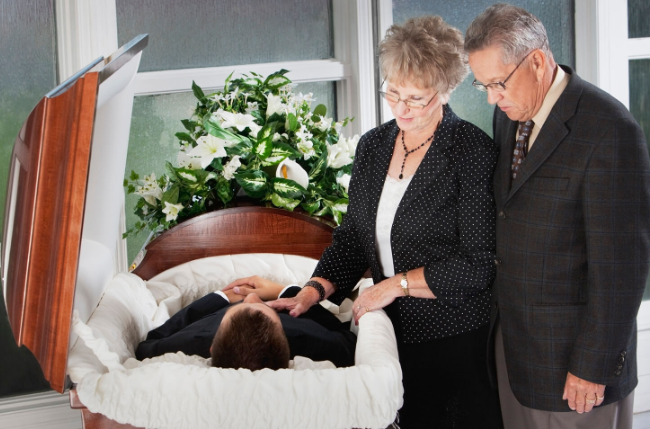Why are People Buried Without Shoes? [Fact Check]
Decoding the Custom: A Look Into Historical Burial Practices and Shoes
From time immemorial, humans have held certain customs, rituals, and beliefs around the concept of death and burial. One intriguing practice is the tradition of burying the deceased without shoes. A plethora of reasons underlie this custom, with the origins and interpretations varying significantly across cultures and time. In this article, we aim to delve deeper into the historical, cultural, religious, and practical reasons for this ritual, bringing together a spectrum of explanations to answer the question: Why are people buried without shoes?
Cultural Beliefs About Barefoot Burials

In many cultures, the act of being barefoot symbolizes purity, humility, and respect. This is a sentiment that frequently extends to burial practices. The deceased, by shedding their shoes, are returning to the earth in the most natural state, making the transition from the physical realm to the spiritual one. This practice was particularly prevalent in ancient civilizations, where shoes were seen as a symbol of earthly attachments and thus, were removed before burial.
Religious Perspectives on Shoeless Burial

Religion often plays a significant role in burial customs. In Christianity, for instance, being barefoot is a sign of humility before God. Some interpret it as emulating Christ, who himself was barefoot when crucified. In contrast, Islam specifies that the deceased should be dressed in simple, unsewn white garments, emphasizing simplicity and equality in death. Hence, the tradition of shoeless burials is closely tied to religious beliefs about the afterlife and spiritual purification.
Practical Reasons for Not Wearing Shoes During Burials

Beyond spiritual and cultural implications, there are practical reasons for shoeless burials. In earlier times, shoes were valuable commodities, and burying them with the dead would have been seen as wasteful. This practical consideration could have contributed to the tradition of burying people without shoes. Moreover, in many cultures, the emphasis is placed on simplicity and eco-friendliness in funerals, and this aligns with the idea of a shoeless burial.
Symbolism of Barefoot Graves
Symbolically, a barefoot burial could signify the deceased’s return to their most primitive, unadorned state – a return to the earth from whence they came. The concept of “ashes to ashes, dust to dust” echoes this sentiment, reinforcing the idea of a cycle of life and death that is intimately tied to nature.
Comparing Shoeless Burial Practices Across Cultures
Examining shoeless burial practices across cultures can provide a fascinating glimpse into humanity’s diverse approaches to death and the afterlife. For instance, among the Maasai people of East Africa, the dead are often left uncovered in the wilderness. They see death as a natural part of life and the environment. On the other hand, in traditional Chinese culture, shoes or representations of them were sometimes buried with the deceased as part of burial offerings, symbolizing a journey in the afterlife.
The Meaning of Barefootedness in Death Rituals
The act of going barefoot in death rituals is layered with meanings, many of them echoing themes of respect, humility, and reconnection with the earth. Shoes, being man-made, can symbolize human constructs, materialism, and the complexities of life. Their removal can then signify shedding these burdens, returning to simplicity, and embarking on the ultimate journey into the afterlife.
Shoes as Offerings in Funerals
Interestingly, while some cultures adhere to the practice of shoeless burials, others incorporate shoes into their death rituals in a different way. Shoes, especially new ones, can symbolize travel and movement. In some cultures, they are buried with the deceased to aid their journey in the afterlife.
The Anthropological Aspects of Shoeless Graves
Delving into the anthropology of shoeless burials, we find a complex tapestry woven with threads of history, culture, and socio-economic circumstances. Archaeological findings have often uncovered burial sites where the deceased have been laid to rest without shoes. These discoveries have sparked profound discussions among anthropologists and archaeologists, leading to deeper understandings of past societies.
Shoes, being relatively perishable, are rarely preserved in archaeological contexts. Hence, shoeless burials are often the norm, rather than the exception, when analyzing archaeological finds. This fact, combined with the knowledge that shoes were expensive and valuable commodities in many historical periods, further supports the anthropological perspective on shoeless burials.
Origins of Shoeless Burial Customs
Unraveling the origins of shoeless burial customs is a journey through time and space. Burial customs are deeply ingrained within societies and often persist through countless generations. These traditions have origins rooted in ancient civilizations, where the disposal of the dead was carried out with specific rituals that hold spiritual and cultural significance.
For instance, in ancient Greece, the deceased were often buried barefoot, believed to be symbolic of their humility and humanity. Similarly, in ancient Egypt, while shoes were commonly depicted in burial art and sometimes included as grave goods, pharaohs themselves were often mummified barefoot – perhaps to emphasize their spiritual purity in death. These historical insights provide glimpses into the diverse origins of shoeless burial customs across civilizations.
Historical Significance of Shoe Removal in Burials
The act of removing shoes before burial carries significant historical weight. It reflects socio-economic realities of past eras when shoes were costly items not to be wasted. The deceased were often buried in simple shrouds with minimal adornments, preserving precious resources for the living.
In many European societies during the Middle Ages and Renaissance periods, shoeless burials were also a symbol of equality in death – a reminder that all earthly possessions, including footwear, have no bearing in the afterlife. Such historical contexts underline the evolving social and economic considerations surrounding shoeless burials.
Comparing Shoeless Burial Practices Across East and West
When comparing Eastern and Western burial practices, the cultural complexities and nuances surrounding shoeless burials become apparent. In many Western cultures, particularly those influenced by Christian traditions, being buried barefoot has long been a symbol of humility and equality before God.
On the other hand, Eastern cultures, particularly those influenced by Buddhism, Hinduism, or Shinto, often place significant emphasis on ritual purification. The removal of shoes, a point of contact with the impurities of the earth, is part of this purification process in death, aligning with the belief in a spiritual journey post-death.
The Media and Literature’s Depiction of Shoeless Burials
Shoeless burials have been depicted in various forms of media and literature, often used as powerful symbols. For instance, in literature, a shoeless burial might be employed as a symbol of poverty or a return to earthy simplicity. In films or television, barefoot burials can convey deep themes of equality in death, humility, or spiritual journeying.
These portrayals not only reflect our cultural and historical understanding of shoeless burials but also shape the way we perceive and understand this practice. They remind us of the continuing relevance of this seemingly simple act and its profound implications about life, death, and what lies beyond.
Frequently Asked Questions About Why are People Buried Without Shoes?
Are there health or environmental considerations for not using shoes in burials?
Yes, eco-friendly and natural burials often prefer the deceased to be buried without shoes. It’s a practice that minimizes the environmental impact and promotes decomposition.
How do different cultures approach footwear in funerals?
Cultural practices regarding footwear in funerals are diverse. Some cultures view barefoot burials as a symbol of humility and respect, while others include shoes as offerings for the deceased’s journey in the afterlife.
Are there any contemporary societies that still practice shoeless burials?
Yes, several contemporary societies, especially those following natural or green burial practices, still prefer shoeless burials.
Also Read: Can You Wash on Cloud Shoes? [Explain in 5 Easy Steps]
Conclusion
Peering through the lens of culture, religion, practicality, and symbolism, we can appreciate the profound significance behind the seemingly straightforward practice of shoeless burials. This custom, steeped in history and imbued with layers of meaning, transcends geographic boundaries and cultural divides, echoing universal themes of humility, respect, and the cyclical nature of life and death. In every shoeless burial, we find a poignant testament to our shared humanity and our varied interpretations of the mysteries of life, death, and the afterlife. As we continue to explore and understand these practices, we come closer to unraveling the complex and beautiful tapestry of human civilization and our timeless quest to make sense of our existence.
As we reach the end of our discussion on “Why are People Buried Without Shoes?” we believe that the information presented here has not only expanded your understanding but also paved the way for practical applications in your own life.



![How to Cancel Just Eat Order? [Get Your Money Back Instantly]](https://webenterpreneurs.com/wp-content/uploads/2023/08/How-to-Cancel-Just-Eat-Order-768x432.png)
![How to Revive a Dying Cordyline? [Steps to Help Them in Recovering]](https://webenterpreneurs.com/wp-content/uploads/2023/08/How-to-Revive-a-Dying-Cordyline--768x432.png)

